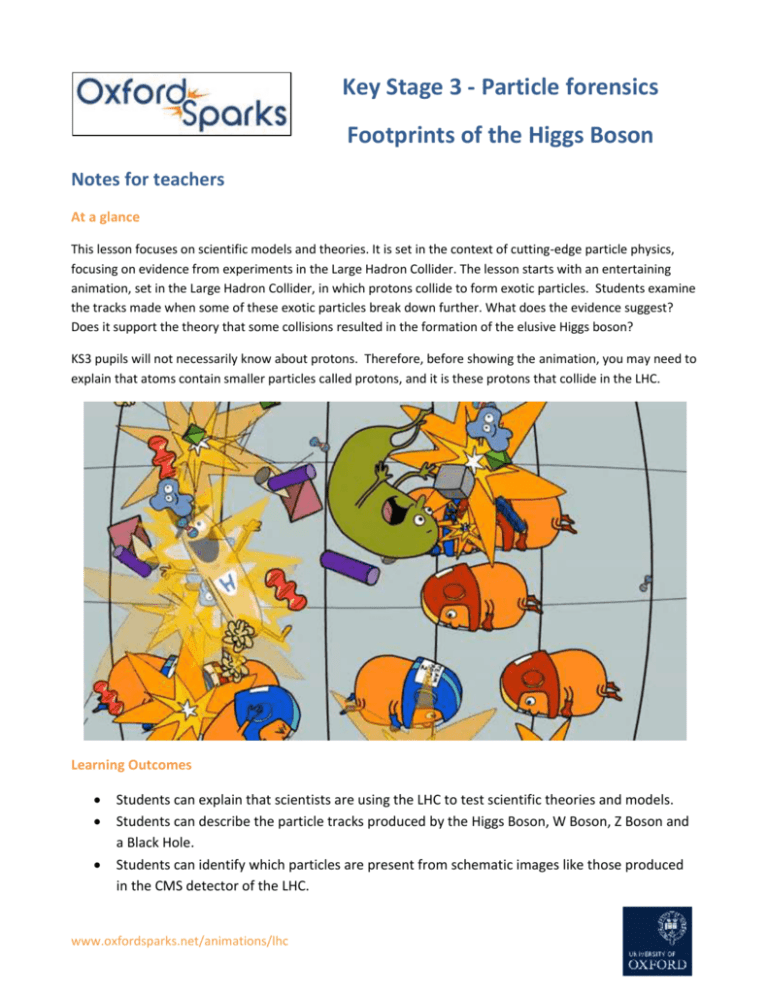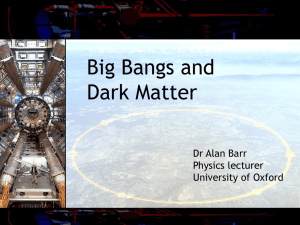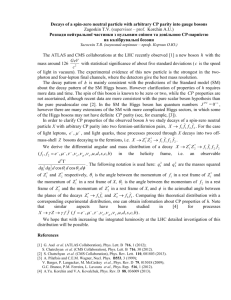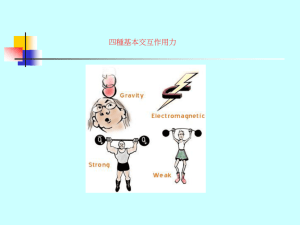Word
advertisement

Key Stage 3 - Particle forensics Footprints of the Higgs Boson Notes for teachers At a glance This lesson focuses on scientific models and theories. It is set in the context of cutting-edge particle physics, focusing on evidence from experiments in the Large Hadron Collider. The lesson starts with an entertaining animation, set in the Large Hadron Collider, in which protons collide to form exotic particles. Students examine the tracks made when some of these exotic particles break down further. What does the evidence suggest? Does it support the theory that some collisions resulted in the formation of the elusive Higgs boson? KS3 pupils will not necessarily know about protons. Therefore, before showing the animation, you may need to explain that atoms contain smaller particles called protons, and it is these protons that collide in the LHC. Learning Outcomes Students can explain that scientists are using the LHC to test scientific theories and models. Students can describe the particle tracks produced by the Higgs Boson, W Boson, Z Boson and a Black Hole. Students can identify which particles are present from schematic images like those produced in the CMS detector of the LHC. www.oxfordsparks.net/animations/lhc Possible Lesson Activities 1. Starter activity Show the animation ‘A quick look around the LHC’ to the class. Show the class the variety of particles that are produced and emphasise the point that when protons collide, you don’t get bits of protons but a range of exotic particles, one of which might be a Higgs Boson. During the animation you can see that particles like the Higgs Boson are produced on collision and then quickly degrade before reaching the detectors. Pose the question 'How do physicists know what particles have been produced by collisions if they break down before reaching the detector?’ Explain that just as you can track an animal by looking for its footprints in the ground, you can track particles by looking for the tracks they leave in the detectors. However, specific particles don’t always degrade in the same way, so different tracks or marks can be evidence for the same particle. 2. Main activity: Looking for the footprints of particles produced on collision Divide class into pairs and give each a copy of the Pupil Worksheet. Part 1 shows the paths that electrons/antielectrons, muons/antimuons and neutrinos/antineutrinos make in the detectors. Note that the particle tracks bend depending on their charge – a positive charge in one direction and a negative charge in the other. Ask pupils to complete Pupil Worksheet Part 2. First go through a worked example for the W boson, which breaks up into an electron and an antineutrino. Ask pupils to then copy this into Part 2 of their worksheet. Now ask the groups to work through all the other examples. You may decide to ask each pair to work individually to start with. One could work through examples 2-5 and the other 6-8, before they share their answers with each other and then share these again in groups of four. Ask groups to self-mark their drawings from the answer sheet provided. Pose the question ‘The Z boson could also decay into a neutrino and an antineutrino. Why don't we try to identify it by looking for this signature?’ Give each group a copy of Pupil Worksheet Part 3, showing collision images from different particles. Ask the groups to complete the activity. 3. Plenary Work through each image in Pupil Worksheet Part 3 again and choose a group to explain what particles they think are present in each collision and why. End by asking if there is any evidence to support the theory that the Higgs Boson was present. www.oxfordsparks.net/animations/lhc Further information about the tracks Pupils may wonder why the electron tracks don’t vanish cleanly, but disappear in a shower of particle tracks. This is because as they pass through the detector, they lose energy, and this energy allows new particles to be created. These too are detected, resulting in the ‘messy’ tracks. Muons don’t display this effect because they pass through the detector almost unimpeded: in fact, the outermost layer of the CMS experiment is made up of ‘muon chambers’, and anything which makes it all the way out to them is almost certainly a muon. Ghostly neutrinos leave no tracks at all because they barely interact with anything. There are billions passing through your body, and indeed the whole Earth, every second of every day, without you noticing! The CMS detector contains a powerful (4 Tesla) solenoid magnet. The tracks of the charged particles bend in that field, with a curvature that depends on the both the local direction of the magnetic field and the charge of the particle. www.oxfordsparks.net/animations/lhc Answer sheet for pupil worksheet part 2 What do the particles formed on collision of the protons break down into? Type of particle formed on collision 1. W Boson What it breaks down into Electron + antineutrino 2. W Boson Muon + antineutrino 3. Z Boson Electron + antielectron www.oxfordsparks.net/animations/lhc Drawing 4. Z boson Muon + antimuon 5. Black hole Lots of particles 6. Higgs Boson 2 x electron + 2 x antielectron www.oxfordsparks.net/animations/lhc 7. Higgs Boson 2 x muon + 2x antimuon 8. Higgs Boson electron + antielectron + muon + antimuon www.oxfordsparks.net/animations/lhc






